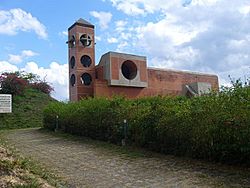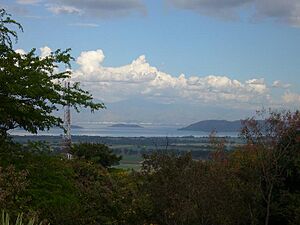Güigüe Abbey facts for kids

Güigüe Abbey church
|
|
| Monastery information | |
|---|---|
| Other names | San José Abbey |
| Order | Congregation of Missionary Benedictines of Saint Ottilien, Order of Saint Benedict |
| Established | April 2, 1923 |
| Mother house | St. Ottilien Archabbey |
| Dedicated to | St Joseph |
| Diocese | Valencia |
| People | |
| Founder(s) | Abbot Fr Norbert Weber, OSB |
| Abbot | José María Martínez Barrera |
| Site | |
| Location | Güigüe, Carabobo, Venezuela |
San José Abbey, located in Güigüe, Venezuela, is a special kind of monastery. It belongs to the Benedictine monks. These monks are part of the Congregation of Missionary Benedictines of Saint Ottilien.
This abbey is currently found south of Lago de Valencia. It started as a mission in Caracas after World War I. But Caracas grew too much, so the monks moved to Güigüe in the late 1980s. The leader of the community is Abbot José María Martínez Barrera.
Contents
History of Güigüe Abbey
Starting in Caracas
The first group of Missionary Benedictine monks came to Caracas, Venezuela. This happened on April 2, 1923. They came because their leader, Archabbot Norbert Weber, wanted to spread their work. After World War I, they learned it was important to have monks in different parts of the world. This would help their missions survive if another big problem happened.
The monks took over a boys' boarding school in Caracas. There was also a special place there dedicated to St Joseph. The monks continued to care for this shrine. Some of the first monks had experience from missions in Africa. Others had tried to start a monastery in Argentina.
The monks kept running the school. They also added technical training for the boys. Many people visited the St. Joseph shrine. This allowed the Benedictines to show their kindness and welcome visitors. A group called "Pia Union de San José del Avila" helped the monks. This support was very helpful. In the beginning, the monastery focused on raising money for the Congregation's missions.
At first, only German monks joined the monastery. But World War II stopped this. The Nazi government closed the Congregation's monasteries in Germany. So, the Venezuelan monastery needed local people to join. It was hard to get Venezuelans to join because the abbey felt very German. They tried to get monks from Spain to help. But still, not many local people joined. In 1961, the monks opened a new house in Bogotá, Colombia. This was to help find and train local monks.
Moving to Güigüe
In 1964, San José del Avila became an abbey. This meant it was a more important monastery. Fr Abbot Theobald Schmid became its leader. The community had monks from many countries. These included Germany, Switzerland, Spain, and France.
But as the community grew, so did the city of Caracas. By 1976, the monastery was very noisy. It was too close to busy eight-lane highways. So, in 1981, the monks decided to move. They wanted to go to a quiet, rural area. This new place was about 150 kilometers southwest of Caracas.
On August 10, 1985, the monks moved to a temporary home. This was in Camuri Chaco, east of Caracas. Their new monastery in Güigüe was still being built.

The new monastery in Güigüe looks very modern. It is quite different from the old shrine in Caracas. It took four years to build. The monks finally moved into their new home in 1990. On June 20, 1990, the archbishop of Valencia blessed the abbey's church.
Moving to Güigüe changed what the monks focused on. Now, they mostly welcome guests and offer spiritual guidance. Farming also helps them earn money.
Other Monasteries
- El Rosal: This monastery was started near Bogotá, Colombia, in 1961. It became a simple monastery in 1963. Its goal was to find and train local monks. In 1992, it became a more important monastery. It has eight monks. Fr Prior Marcos Dworschak leads them.
- Camuri Chaco: The Missionary Benedictines have owned this land since 1948. Güigüe Abbey has rented out this land since 1988.
The Monks of Güigüe Abbey
Like many religious groups, Güigüe Abbey has seen fewer people join since the Second Vatican Council. In 1970, the community had 54 monks. As of May 18, 2011, Güigüe Abbey has ten monks who have made their final promises. Four of them are priests. The monastery also has two new monks in training and one lay helper.
Abbot José María Martínez Barrera leads Güigüe Abbey. He was first chosen as abbot in 1982. He stepped down in 2002. From 2007 to 2011, he helped manage the community. Martínez Barrera was chosen as abbot again on January 11, 2011.
See also
 In Spanish: Abadía de Güigüe para niños
In Spanish: Abadía de Güigüe para niños
- Congregation of Missionary Benedictines of Saint Ottilien
- Order of Saint Benedict

